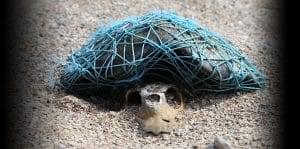
The ocean is the birthplace of life, and it’s still the wellspring from which all of life is drawn. Because the ocean is mostly invisible to humanity, however, we’ve done a terrible job of maintaining it. That’s the central point of Blue, a new wildlife conservation documentary from director Karina Holden.
The best thing about Blue is its haunting underwater cinematography. Because of the dire subject matter, this isn’t the kind of movie you can cozy up to with an attitude of, “heh, heh, fish are cool,” ala The Blue Planet or Planet Earth. But the shots of massive schools of fish, roaming sharks, and struggling coral reefs will blow you away nonetheless. The filmmakers went all out on making the underwater camerawork striking and mesmerizing.
The film comprises a series of vignettes that each profile one marine/sustainability activist’s work. We watch them dive into the depths, clean up beaches, and examine affected wildlife as we listen to them discuss the problems facing the ocean today. Almost all of the movie is narrated by these people, and the fact that they’re reading a script (not doing in-person interviews) gives Blue a dreamlike quality.

“…our constant ocean harvesting will ultimately hurt our species…”
Everyone involved in the production of Blue clearly cares about animal rights, and as someone who really likes eating fish, some of the arguments didn’t move me. Viewers’ opinions may vary, but sharks scare me, and I don’t personally care if some of them die. However, Blue is careful to make most of its points human-centric: the viewer comes away with the impression that our constant ocean harvesting will ultimately hurt our species too.
There were some problems that prevented Blue from persuading me at certain points. Most scenes outside of the ocean—on beaches, in fish markets, etc.—are filmed in slow motion. This might have been a choice for the sake of stylistic unity, but there were way too many shots of the narrators walking around in slow motion for my taste. The scenes of dead animals being mutilated have an undeniable power, but that power is undercut somewhat by marine activists looking glumly at the corpses. One thing Blue isn’t is subtle—every minute of the film telegraphs exactly how it wants the viewer to feel.

“…filmmakers went all out on making the underwater camerawork striking and mesmerizing.”
But moral clarity isn’t a bad thing when you can back it up. The narrators frequently drop statistics that shocked me: it’s estimated that one-third of the fish in global markets is caught illegally. A factory-scale fishing boat will catch as many fish in a day as a small fisherman does in a year. Half of all marine life has disappeared in the past several decades. The most horrifying scene in the movie comes under a microscope: through some kind of spectral lighting, we see micro-particles of plastic that have been absorbed into a single plankton’s body. If the base of the marine food chain has been inundated with plastic, how much of the meat we eat—and our own bodies—is full of toxic plastics too?
Blue reminded me of the Joseph Stalin quote, “A single death is a tragedy, a million deaths is a statistic.” Of course, that’s not really true, but as a matter of perspective and human psychology, it’s harder to process widespread devastation than a single traumatic event. This is probably why Blue has far less emotional power than the similarly themed The Cove. The latter film focuses on a dolphin-fishing community in Japan, and its director builds the whole movie around getting the audience to care about one “catch.” Blue’s wide-ranging, episodic structure makes it easier to connect with as an argument, a catalogue of points, than as an emotional story. However, I probably won’t order the shark fin soup if I ever visit Hong Kong, so in that sense, the film has done its job.

Blue (2017) Written and directed by Karina Holden. With Lucas Handley, Madison Stewart, Tim Silverwood, Phillip Mango, Valerie Taylor, Dr Jennifer Lavers, Mark Dia.
7 out of 10 beluga whales
